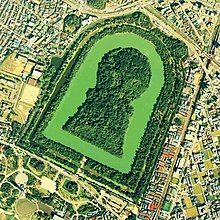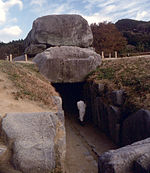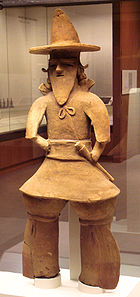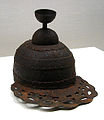Kofun period
| Part of a series on the |
| History of Japan |
|---|
 |
The Kofun period (古墳時代, Kofun jidai) is an era in the history of Japan from around 250 to 538. The word kofun is Japanese for the type of burial mounds dating from this era. The Kofun period follows the Yayoi period. The Kofun and the subsequent Asuka periods are sometimes referred to collectively as the Yamato period. as the chronology of the historical sources are very much distorted, studies of this age require deliberate criticism and the aid of archaeology.
Generally, the Kofun period is divided from the Asuka period for its cultural differences. The Kofun period is illustrated by an shinto culture which existed[citation needed] prior to the introduction of Buddhism. Politically, the leader of the powerful clan, which won control over much of Honshū and the northern half of Kyūshū and eventually established Imperial House of Japan. Also, the Kofun period is the oldest era of recorded history in Japan.
Kofun tombs

Kofun are defined as the burial mounds built for the people of the ruling class during the 3rd to 7th centuries in Japan,[1] and the Kofun period takes its name from these distinctive earthen mounds. The mounds contained large stone burial chambers. Some are surrounded by moats.
Kofun come in many shapes, with round and square being the simplest. A distinct style is the keyhole-shaped kofun, with its square front and round back. Kofun range in size from several meters to over 400 meters in length. The clay figure that was called Haniwa was buried under the circumference.
Development

The oldest Japanese kofun is said to be Hokenoyama Kofun located in Sakurai, Nara, which dates to the late 3rd century. In the Makimuku district of Sakurai, later keyhole kofuns (Hashihaka Kofun, Shibuya Mukaiyama Kofun) were built around the early 4th century. The trend of the keyhole kofun first spread from Yamato to Kawachi (where gigantic kofun such as Daisenryō Kofun exist), and then throughout the country (except for Tōhoku region) in the 5th century. Keyhole kofun disappeared later in the 6th century, probably because of the drastic reformation which took place in the Yamato court; Nihon Shoki records the introduction of Buddhism at this time. The last two great kofun are the Imashirozuka kofun (length: 190m) of Osaka, which is believed by current scholars to be the tomb of Emperor Keitai, and the Iwatoyama kofun (length: 135m) of Fukuoka which was recorded in Fudoki of Chikugo to be the tomb of Iwai, the political archrival of Keitai.
Yamato court
While conventionally assigned to the period from 250 AD, the actual start of Yamato rule is disputed. The start of the court is also linked with the controversy of Yamataikoku and its fall. Regardless, it is generally agreed that Yamato rulers possessed keyhole kofun culture and held hegemony in Yamato up to the 4th century. The regional autonomy of local powers remained throughout the period, particularly in places such as Kibi (current Okayama prefecture), Izumo (current Shimane prefecture), Koshi (current Fukui and Niigata prefecture), Kenu (northern Kantō), Chikushi (northern Kyūshū), and Hi (central Kyūshū); it was only in the 6th century that the Yamato clans could be said to be dominant over the entire southern half of Japan. On the other hand, Yamato's relationships with China is likely to have begun in the late 4th century, according to the Book of Song.
The Yamato polity, which emerged by the late 5th century, was distinguished by powerful clans (豪族: Gōzoku). Each clan was headed by a patriarch (氏上: Ujikami) who performed sacred rites to the clan's kami to ensure the long-term welfare of the clan. Clan members were the aristocracy, and the kingly line that controlled the Yamato court was at its pinnacle. Powerful clan leaders awarded kabane, a title that denoted a political rank. This title was inherited, and used instead of the family name.
The Kofun period of Japanese culture is also sometimes called the Yamato period by some Western scholars, since this local chieftainship arose to become the Imperial dynasty at the end of the Kofun period. Yamato and its dynasty however were just one rival polity among others throughout the Kofun era. Japanese archaeologists emphasise instead the fact that in the early half of the Kofun period other regional chieftainships, such as Kibi were in close contention for dominance or importance. The Tsukuriyama Kofun of Kibi is the fourth largest kofun in Japan.

The Yamato court ultimately exercised power over clans in Kyūshū and Honshū, bestowing titles, some hereditary, on clan chieftains. The Yamato name became synonymous with all of Japan as the Yamato rulers suppressed the clans and acquired agricultural lands. Based on Chinese models (including the adoption of the Chinese written language), they started to develop a central administration and an imperial court attended by subordinate clan chieftains but with no permanent capital. The famous powerful clans were the Soga, Katsuraki, Heguri, Koze clans in the Yamato and Bizen Province, and the Kibi clans in the Izumo Province. The Ōtomo and Mononobe clans were the military leaders, and the Nakatomi and Inbe clans handled rituals. The Soga clan provided the highest minister in the government, while the Ohtomo and Mononobe clans provided the second highest ministers. The heads of provinces were called Kuni-no-miyatsuko. The crafts were organized into guilds.
The Yamato court had ties to the Gaya confederacy, called Mimana in Japanese. There is archaeological evidence from the Kofun tombs, which show similarities in form, art, and clothing of the depicted nobles. Based on the Kojiki and the Nihon Shoki, Japanese kokugaku historians claimed Gaya to be a colony of the Yamato state, a theory that is now widely rejected. More likely all these states were tributaries to the Chinese dynasties to some extent. However, Chinese scholars point to the Book of Song of the Liu Song Dynasty, written by the Chinese historian Shen Yue (441-513), presenting the sovereign of Japan as the suzerain of the Gaya Confederacy. This interpretation is also widely rejected even in Japan as there is no evidence of Japanese rule in Gaya or any other part of Korea.[2][3] In addition, the Book of Song was incomplete with missing volumes and filled in centuries later in a biased manner for political reasons.
In recent years, tumulus or Kofun in Japanese can be found with jades in Japan, Baekje area and Gaya confederacy area.[4][5]
Territorial expansion of Yamato

In addition to archaeological findings indicating a local monarchy in the Kibi Province as an important rival, the legend of the 4th century Prince Yamato Takeru alludes to the borders of the Yamato and battlegrounds in the area. A frontier was obviously somewhere close to the later Izumo province (the eastern part of today's Shimane prefecture). Another frontier, in Kyūshū, was apparently somewhere north of today's Kumamoto prefecture. The legend specifically states that there was an eastern land in Honshū "whose people disobeyed the imperial court", against whom Yamato Takeru was sent to fight. That rivalling country may have been located rather close to the Yamato nucleus area itself, or relatively far away. The today Kai province is mentioned as one of the locations where prince Yamato Takeru sojourned in his said military expedition.
Northern frontier of this age was also explained in Kojiki as the legend of Shido Shogun's (四道将軍: Shoguns to four ways) expedition. Out of four shoguns, Ōbiko set northward to Koshi and his son Take Nunakawawake set to eastern states. The father moved east from northern Koshi while the son moved north on his way, and they finally met at Aizu (current western Fukushima). Although the legend itself is not likely to be a historical fact, Aizu is rather close to southern Tōhoku, where the north end of keyhole kofun culture as of late 4th century is located.
Ōkimi

During the Kofun period, a highly aristocratic society with militaristic rulers developed.
The Kofun period was a critical stage in Japan's evolution toward a more cohesive and recognized state. This society was most developed in the Kinai Region and the easternmost part of the Inland Sea. Japan's rulers of the time even petitioned the Chinese court for confirmation of royal titles.
While the rulers' titles are diplomatically King, they locally titled themselves as Ōkimi (Great King) during this period. Inscriptions in two swords, Inariyama Sword and Eta Funayama Sword had records of Amenoshita Shiroshimesu(治天下; "ruling of Heaven and Earth") and Ōkimi(大王) in common, to be a ruler that the bearers of these swords were subjected to. It reveals that rulers of this age also grasped religious authorities to justify their thrones through heavenly dignities. The title of Amenoshita Shiroshimesu Okimi was used up to 7th century, until being replaced by Tenno.
Clans of the Yamato Court
Many of the clans and local chieftains that made up the Yamato polity claimed descent from the imperial family or other tribal Gods. The archeological evidence for such clans is found in the Inariyama sword, on which the bearer recorded the names of his ancestors to claim its origin to Ōbiko (大彦) who was recorded in Nihon Shoki as a son of Emperor Kōgen. On the other hand, there are also a number of clans having origins in China or the Korean peninsula.
In the 5th century, the Kazuraki clan (葛城氏), descending from the legendary grandson of Emperor Kōgen, was the most prominent power in the court and intermarried with the imperial family. After Kazuraki declined in the late 5th century, the Ōtomo clan temporarily took its place. When Emperor Buretsu died with no apparent heir, it was Ōtomo no Kanamura who recommended Emperor Keitai, a very distant imperial relative who resided in Koshi Province, as the new monarch. However, Kanamura resigned due to the failure of his diplomatic policies, and the court was eventually controlled by the Mononobe and Soga clans at the beginning of the Asuka period.
Kofun society

Toraijin
Chinese and Korean immigrants who were naturalized in ancient Japan were called toraijin. They introduced many aspects of Korean and Chinese culture to Japan. Valuing their knowledge and culture, the Yamato government gave preferential treatment to toraijin. The elements of Chinese culture introduced to the Yamato Imperial Court are very important.[3] According to the book Shinsen Shōjiroku compiled in 815, a total 154 out of 1,182 noble families in the Kinai are on Honshū Island were regarded as people with foreign genealogy. The book specifically mentions 163 were from China, 104 such families from Baekje, 41 from Goguryeo, 6 from Silla, and 3 from Gaya.[6] They might be families that moved to Japan between the years A.D.356-645.
Chinese migration
Many important figures were also immigrants from China. Chinese immigrants also had considerable influence according to the Shinsen Shōjiroku,[6] which was used as a directory of aristocrats. Yamato Imperial Court had officially edited the directory in 815, and 163 Chinese clans were registered.
According to Nihon Shoki, the Hata clan, which was composed of descendants of Qin Shi Huang[7], arrived at Yamato in 403 (the fourteenth year of Oujin) leading the people of 120 provinces. According to the Shinsen Shōjiroku, the Hata clan were dispersed in various provinces during the reign of Emperor Nintoku and were made to undertake sericulture and the manufacturing of silk for the court. When the finance ministry was set up in Yamato Court, Hata Otsuchichi (秦大津父) was in charge of accounts as a minister of it.
In 409 (twentieth year of Oujin), Achi-no-Omi ancestor of the Yamato-Aya clan which was composed of also arrived with the people of 17 districts. According to the Shinsen Shōjiroku, Achi obtained the permission to establish the Province of Imaki. The Kawachi-no-Fumi clan, descendants of Gaozu of Han, introduced aspects of Chinese writing to the Yamato court.
The Takamuko clan is a descendant of Cao Cao. Takamuko-no-Kuromaro was a center member of Taika Reform.[8]
Korean migration
Among the many Korean immigrants who settled in Japan beginning in the 4th century, some came to be the progenitors of Japanese clans. According to Kojiki and Nihon Shoki, the oldest record of a Silla immigrant is Amenohiboko, a legendary prince of Silla who settled to Japan at the era of Emperor Suinin, perhaps around the 3rd or 4th century.
Korean immigrants also include the Baekje royal family. King Muryeong of Baekje was born in 462, and left a son in Japan who settled there. According to the historical documents in the Nihon Shoki, his father was sent to Japan as a hostage but that interpretation is questionable since the ruler of Japan Emperor Tenno's grandfather was Korean. Due to the confusion on the exact nature of this relationship of whether the Koreans were family to the Imperial line or hostages and the fact that the Nihon Shoki is a compilation of myth make it difficult the evaluate.[9]
Language
Chinese, Korean and Japanese wrote accounts of history mostly in Chinese characters, making original pronunciations difficult to trace.
While writing was largely unknown to the indigenous Japanese of this period, the literary skills of foreigners seem to have increasingly become appreciated by the elites of some Japanese regions. The Inariyama sword, made in either China (tentatively dated 471 or 531) contains Chinese-character inscriptions in styles used in China, leading to speculation that the owner, though claiming to be a Japanese aristocrat, might possibly actually have been an immigrant. [10]
Introduction of equine culture to Japan


The cavalry wore armour, carried swords and other weapons, and used advanced military methods like those of north-east Asia. Evidence of these advances is seen in Haniwa(埴輪), the "clay ring" placed on and around the tomb mounds of the ruling elite. The most important of these haniwa were found in southern Honshū—especially the Kinai region around Nara prefecture—and northern Kyūshū. Haniwa grave offerings were made in numerous forms, such as horses, chickens, birds, fans, fish, houses, weapons, shields, sunshades, pillows, and male and female humans. Another funerary piece, the magatama, became one of the symbols of the power of the imperial house.
Much of the material culture of the Kofun period is barely distinguishable from that of the contemporaneous southern Korean peninsula, demonstrating that at this time Japan was in close political and economic contact with continental Asia (especially with the southern dynasties of China) through Korea. Indeed, bronze mirrors cast from the same mould have been found on both sides of the Tsushima Strait. Irrigation, sericulture, and weaving were also brought to Japan by Chinese and Korean immigrants who are mentioned in the ancient Japanese histories. For instance, the Hata clan, of Chinese origin, introduced sericulture.[citation needed]
Towards Asuka period
The Kofun period gave way to the Asuka period in mid-6th century AD inwith the introduction of Buddhism. The religion was officially introduced the year 538, and this year is traditionally taken as the start of the new period. The Asuka period also coincided with the reunification of China under the Sui Dynasty later in this century. Japan became deeply influenced by Chinese culture, adding a broader cultural context to the religious distinction between the Kofun and Asuka periods.
Relations between the Yamato court and the Korean kingdoms
Chinese and Korean records
- According to the Book of Sui, Silla and Baekje greatly valued relations with Wa (Japan) of the Kofun period, and the Korean kingdoms made diplomatic efforts to maintain their good standing with the Japanese. [11]
- According to the Gwanggaeto Stele, Silla and Baekje were Client state of Goguryeo. However part of the stele can be translated in 4 different ways depending on how you fill in the missing characters and where you punctuate the sentence. [12]
This has caused controversy between the two nations.
- According to the Samguk Sagi (Chronicles of the Three Kingdoms), Baekje and Silla sent their princes as hostages to the Yamato court in exchange for military support to continue their already-begun military campaigns; King Asin of Baekje sent his son Jeonji in 397[13] and King Silseong of Silla sent his son Misaheun in 402.[14]
- According to the Book of Song, a Chinese emperor appointed five kings of Wa to Supervisor of All Military Affairs of the Six Countries of Wa, Silla, Imna, Gara, Chinhan, and Mahan in 451[15]
Japanese records
According to the Nihon Shoki, Silla was conquered by the Japanase Empress-consort Jingū in the third century. [16]
According to Nihon Shoki, The prince of Silla came to Japan to serve the Japanese Emperor[17], and he lived in Tajima Province. He was called Amenohiboko. His descendant is Tajima mori. [18]
According to Kojiki [19] Nihon Shoki[20], In Emperor Ōjin's reign, Geunchogo of Baekje presented Stallions and Broodmares with Horse trainers to the Japanese emperor.[21]

-
Kofun helmet, iron and gilt copper.
-
Kofun armor, iron plates sewn with leather.
-
Kofun armor.
-
Kofun helmet.
-
Kofun shield.
-
Kofun royal crown
Keyhole kofun
Keyhole kofuns were also recently discovered in the Gaya confederacy region of the Korean peninsula. This has caused scholars to begin examining the shared relationship between the Yamato and Baekje during the 3rd and the 7th centuries AD, including the method of tomb construction. While a variety of theories exist, most have come to the conclusion that there was sharing of culture and construction methods both directions.[22] For example, earrings discovered in Silla and Kaya tombs are very similar to Japanese earrings dated to the Kofun period, "The ultimate source of such elaborate techniques as granulation is probably the Greek and Etruscan goldsmiths of western Asia and Europe, whose skills were transmitted to northern China and later to Korea. The resemblance of earrings found in Japan in the Kofun period (ca. 3rd century—538 A.D.) to those from Silla and Kaya tombs suggests that such articles are imported from Korea."[23] Spread of Chinese civilisation, Han styles of tomb construction were gradually adopted in all three kingdoms of Korea, mainly from the 4th century onwards.[24] The tombs in the southern part of Korea and Japan appear to have a relationship.[22] However, all the kofun-style tombs discovered in Korea have been dated as younger than those found in Japan.leading Japanese scholars to insist that those found in Korea were either built by Japanese immigrants or influenced by culture brought by them.[22] but the advanced artifacts found in Japan's kofun tombs are Korean leading scholars to not be able to conclude anything.
See also
Notes
- ^ Keally, Charles T. (2009-04-29). "Kofun Culture". Retrieved 2009-05-30.
- ^ Lee (1997:31-35)
- ^ a b Kōzō (1997:308-310) Cite error: The named reference "Kōzō" was defined multiple times with different content (see the help page).
- ^ The Hankyoreh 2001.9.6[1](in korean)
- ^ Yoshida (1997:74-78)
- ^ a b Saeki (1981)
- ^ "Nihon no myōji 7000 ketsu seishi ruibetsu taikan Hata uji 日本の苗字7000傑 姓氏類別大観 秦氏". Retrieved 2006-05-31.
- ^ "Nihon no myōji 7000 ketsu seishi ruibetsu taikan Takamuko uji 日本の苗字7000傑 姓氏類別大観 高向氏". Retrieved 2006-10-15.
- ^ Nihon Shoki "Chronicle of Emperor Yūryaku" 六月丙戌朔 孕婦果如加須利君言 於筑紫各羅嶋産兒 仍名此兒曰嶋君 於是 軍君即以一船 送嶋君於國 是爲[[武寧王 百濟人呼此嶋曰主嶋也
- ^ Seeley (2000:19-23)
- ^ Chinese History Record Book of Sui, Vol. 81, Liezhuan 46 : 隋書 東夷伝 第81巻列伝46 : 新羅、百濟皆以倭為大國,多珍物,並敬仰之,恆通使往來 "Silla and Baekje both take Wa to be a great country, with many rare and precious things; also [Silla and Baekje] respect and look up to them, and regularly send embassies there." [2][3]
- ^ 百残新羅舊是属民由来朝貢而倭以辛卯年来渡海破百残XX新羅以為臣民
- ^ Korean History Record Samguk Sagi : 三國史記 新羅本紀 : 元年 三月 與倭國通好 以奈勿王子未斯欣爲質 [4]
- ^ Korean History Record Samguk Sagi : 三國史記 百済本紀 : 六年夏五月 王與倭國結好 以太子腆支爲質 秋七月大閱於漢水之南 [5]
- ^ Chinese History Record Book of Song : 宋書 列傳第五十七 夷蠻 : 詔除武使持節、都督倭新羅任那加羅秦韓慕韓六國諸軍事、安東大將軍、倭王。興死,弟武立,自稱使持節、都督倭百濟新羅任那加羅秦韓慕韓七國諸軍事、安東大將軍、倭國王[6][7]
- ^ Sakamoto (1967:336-340)
- ^ Nihon Shoki, Vol.6 "天日槍對曰 僕新羅國主之子也 然聞日本國有聖皇 則以己國授弟知古而化歸(to serve)之"
- ^ Nihon Shoki, Vol.6 "故天日槍娶但馬出嶋人 太耳女麻多烏 生但馬諸助也 諸助生但馬日楢杵 日楢杵生清彦 清彦生田道間守也"
- ^ 百濟國主照古王遣阿知吉師獻雄馬雌馬各壹以貢上此阿知吉師者 阿直史等之祖
- ^ 十五年秋八月 壬戌朔丁卯 百濟王遣阿直岐 貢良馬二匹 即養於輕阪上廄 因以阿直岐令掌飼 故號其養馬之處曰 廄阪
- ^ Kurano (1958:248-249)
- ^ a b c Yoshii, Hideo (unknown). "Keyhole-shaped tombs in Korean Peninsula" (PDF). Retrieved 2009-05-30.
{{cite web}}: Check date values in:|date=(help) - ^ "Korea, 1-500 A.D. in Heilbrunn Timeline of Art History". Metropolitan Museam of Art. 2000. Retrieved 2009-05-30.
- ^ Richard Rutt, James Hoare. "Korea: a historical and cultural dictionary (474 page)". Routledge. ISBN 0700704647, 9780700704644.
{{cite web}}: Check|isbn=value: invalid character (help)
References
- Bogucki, Peter (1999). The Origins of Human Society. Blackwell Publishing. ISBN 1-5771-8112-3.
- Farris, William Wayne (1998). Sacred texts and buried treasures : issues in the historical archaeology of ancient Japan. University of Hawai'i Press. ISBN 0-8248-1966-7.
- Imamura, Keiji (1996). Prehistoric Japan: New Perspectives on Insular East Asia. University of Hawaii Press. ISBN 0-8248-1852-0.
- Kōzō, Yamamura (1997). The Cambridge history of Japan. Cambridge University Press. ISBN 0-521-22354-7.
{{cite book}}: Unknown parameter|coauthors=ignored (|author=suggested) (help) - Lee, Kenneth B (1997). Korea and East Asia : the story of a Phoenix. Praeger. ISBN 0-2759-5823-X.
- Kurano, Kenji (1958). Nihon Koten Bungaku Taikei 1: Kojiki, Norito. Iwanami Shoten. ISBN 4-0006-0001-X.
{{cite book}}: Unknown parameter|coauthors=ignored (|author=suggested) (help) - Saeki, Arikiyo (1981). Shinsen Shōjiroku no Kenkyū (Honbun hen) (in Japanese). Yoshikawa Kōbunkan. ISBN 4-6420-2109-4.
- Sakamoto, Tarō (1967). Nihon Koten Bungaku Taikei 67: Nihon Shoki. Vol. 1. Iwanami Shoten. ISBN 4-0006-0067-2.
{{cite book}}: Unknown parameter|coauthors=ignored (|author=suggested) (help) - Seeley, Christopher (2000). A history of writing in Japan. University of Hawai'i Press. ISBN 0-8248-2217-X.
- Stearns, Peter N. (2001). The Encyclopedia of World History. Houghton Mifflin Harcourt. ISBN 0-3956-5237-5.
{{cite book}}: Unknown parameter|coauthors=ignored (|author=suggested) (help) - Yamaguchi, Yoshinori (1997). Shinpen Nihon Koten Bungaku Zenshū 1: Kojiki. Shōgakukan. ISBN 4-09-658001-5.
{{cite book}}: Unknown parameter|coauthors=ignored (|author=suggested) (help) - Yoshida, Takashi (1997). Nihon no tanjō (in Japanese). Iwanami Shoten. ISBN 4-0043-0510-1.

This image is available from the United States Library of Congress Prints and Photographs Division under the digital ID {{{id}}}
This tag does not indicate the copyright status of the attached work. A normal copyright tag is still required. See Wikipedia:Copyrights for more information.
- Japan
This period is part of the Yamato period of Japanese History.
< Yayoi | History of Japan | Asuka period >






